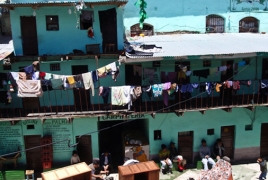 Bolivia’s self-governing jailBizarre tourist attraction Once called “the world’s most bizarre tourist attraction,” Bolivia’s San Pedro prison is notorious for its lack of guards or police interference inside its walls. The prison has around 2,000 inmates, the majority of whom were sentenced on drug charges. PanARMENIAN.Net - Inside the facility, some prisoners confirm cocaine is produced by inmates and smuggled out by visitors and their family members. A society within itself, the prison contains shops and restaurants run by inmates, women and children living voluntarily with imprisoned family members. There is a system of laws and rules created by the inmates themselves, and those who break them are severely punished by the other inmates, some even killed. Authorities usually don’t intervene unless there’s a big riot. Upon entering San Pedro, prisoners are required to purchase a cell from either the “prison mayor” or through one of the prison’s “freelance real-estate agents”. Once a price is agreed on, the buying process is quite formal, with each cell owner receiving a title to their property and copies given to their section leader who verifies the transaction with an official seal and signing of the contract. San Pedro Prison is divided into eight sections, from the most miserable, to the luxurious La Posta sector, where inmates who can afford to live here have large, comfortable cells with private bathrooms, a kitchen, cable television and even jacuzzi. If inmates don’t have the money to buy their own cell, they can either rent a cell from another prisoner or live in a cramped closet paid for with labor. It costs between $1,000 and 1,500 to buy one of these luxurious quarters for a whole sentence, and most of the inmates in the prison live in crowded single-room cells. Some inmates remain homeless and have to make do with hallway floors or the prison’s chapel. News and stories about the free prison of La Paz spread quickly as the Internet became more popular, and tourists started flocking to this unusual place. Many paid around $25 for a tour, and some of the more influential inmates set up tourism operations and started making fortunes. But as rumors about people coming to San Pedro prison with the sole purpose of buying the cocaine made by prisoners inside( rumored to be the purest in Bolivia) spread, authorities finally decided to put their foot down and put an end to the thriving tourism business. San Pedro operates its own economy, with inmates required to pay for their own food, housing, medical care and general upkeep. A few prisoners are supported by family members, however many are left to find jobs within the prison in order to survive. Career prospects include, but are not limited to, restaurant owner, bar tender, messenger, chef, medical adviser, hairdresser and of course drug dealer. Another lucrative income source is the alcohol trade. Money is also made and lost through gambling. Up to US$20,000 in bets are placed per year on inter-section football matches. Families are permitted to live inside the prison and are free to come and go as they please. Women provide an important link to the outside world, purchasing and selling items at La Paz’s market stalls to support their husbands. The 200 children who live inside the prison are either educated in the prison’s two nurseries or in the nearby schools and spend their free time playing inside the prison grounds. Sadly some of these children also fall victim to violence and abuse. In 2013, it was alleged a 12-year-old girl fell pregnant after being raped by her father and several other men. Following the incident, the government announced the facility’s imminent closure, saying that a new jail will be built outside the city and prisoners will be relocated. However, San Pedro prison still remains open. Lusine Mkrtumova / PanARMENIAN.Net How collection of horned creatures turned into museum New York’s first female crime boss World’s largest boneyard An Italian photojournalist’s journey through the pandemic Quarantine in metropoles Town without newborns and dead Nine months in the Pacific |